Study on Location of Bus Stop in Subway Service Area Based on Residents’ Travel Accessibility
Abstract
:1. Introduction
- Based on the influence range of subway and from the perspective of residents’ travel accessibility, this paper used the potential model to improve the characteristics of bus stops. Meanwhile, considering the travel costs of residents and the bus stop infrastructure deployment costs, the location optimization model was established with the full coverage of bus stops as the constraint.
- Using GIS technology, the accessibility of residents was calculated and visualized. Combined with the actual road conditions, the bus stops are deployed to make the bus routing scheme more realistic and reliable.
- Considering the conflict between the two types of objective functions in the model, the non-dominated sorting genetic algorithm II (NSGA-II) was used to solve the problem, and was combined with the entropy weight technique for order of preference by the similarity to ideal solution (TOPSIS) evaluation model to obtain the equilibrium solution that can simultaneously optimize the two conflicting objective functions.
2. Methods
2.1. Improved Potential Model
2.2. Optimization Model
2.3. Algorithm Solution
3. Data Preparation
3.1. Establishment of Basic Data System
3.2. Screening Road Network
- Import basic data: The road network information related to the research scope were obtained from Gaode map, and the road network layer was drawn using ArcGIS.
- Check basic data: Using the ArcGIS topology check function to check the potential errors in the road network data, and reverify the topology after the initial verification to generate a complete and reliable road network topology.
- According to the road grade for running conventional buses, select the road network that is suitable for bus operation, including urban arterials, secondary roads, and minor roads.
3.3. Extract Valid Data
4. Discussion
4.1. Subway Attraction Area
4.2. Accessibility Analysis
4.2.1. Determination of Friction Coefficient
4.2.2. Implementation of Improved Potential Model in ArcGIS
4.2.3. Analysis of Accessibility Results
4.3. Preliminary Layout
- Within the attraction area of subway, the premise for residents to transfer to the subway from conventional bus is that the transfer distance from the bus stop to a subway station is shorter than the maximum acceptable walking distance. Therefore, it is necessary to add bus stops for the residential district with no accessibility to bus stops.
- The service radius of a bus stop is 500 m, which is the maximum acceptable walking distance for residents to take the bus.
- No more bus stops will be developed at other residents’ demand points.
4.4. Algorithm Solution
5. Conclusions
Author Contributions
Funding
Institutional Review Board Statement
Informed Consent Statement
Data Availability Statement
Acknowledgments
Conflicts of Interest
References
- Maria, V.C.; Nicola, F. A Methodology to Evaluate Accessibility to Bus Stops as a Contribution to Improve Sustainability in Urban Mobility. Sustainability 2019, 11, 803. [Google Scholar]
- Li, J.Z.; Xia, T.; Zhu, M. Multi-source data visual analysis method for bus station optimization. Mini-Micro Syst. 2022, 43, 1350–1355. [Google Scholar]
- Cheng, Y.Y.; Guo, J.H.; Jiang, H.X. Matter element analysis and evaluation of bus station layout rationality based on interest point data. Traffic Inf. Saf. 2020, 38, 63–72. [Google Scholar]
- Duan, G.L.; Ma, X.; Wang, J.R.; Wang, Z.S.; Wang, Y. Optimization of Urban Bus Stops Setting Based on Data Mining. Int. J. Pattern Recognit. Artif. Intell. 2021, 35, 2159028. [Google Scholar] [CrossRef]
- Yue, Z.H. Design and Implementation of Bus Station Location Visualization System Based on Multi-Mode Analysis. Ph.D. Thesis, Zhejiang University of Technology, Hangzhou, China, 2020. [Google Scholar]
- Garg, N.; Ramadurai, G.; Ranu, S. Mining bus stops from raw GPS data of bus trajectories. In Proceedings of the 2018 10th International Conference on Communication Systems & Networks (COMSNETS), Bengaluru, India, 3–7 January 2018; pp. 583–588. [Google Scholar]
- Zhu, G.Y.; Zhang, W.X.; Wei, J.; Zhang, P. Research on a bus station location model based on Voronoi diagram. Transp. Res. 2015, 1, 25–30+36. [Google Scholar]
- Ge, B.; Cai, L.; Wang, F. Layout optimization of conventional bus stations based on Thiessen polygon service partition. J. Wuhan Eng. Univ. 2018, 40, 668–672. [Google Scholar]
- Wang, F.; Ye, M.Q.; Zhu, H.B.; Gu, D.J. Optimization Method for Conventional Bus Stop Placement and the Bus Line Network Based on the Voronoi Diagram. Sustainability 2022, 14, 7918. [Google Scholar] [CrossRef]
- Zhao, C. Site location optimization based on GIS-Taking bus No.2 in Xinluo District of Longyan City as an example. Inf. Comput. 2018, 6, 3–5. Available online: http://www.cqvip.com/qk/95974a/201806/7000624859.html (accessed on 28 February 2023).
- Bai, Y.; Liu, W. Research on the optimization of bus station layout based on GIS location allocation model-Taking Nanhu District of Wuhan as an example. Urban Public Traffic 2017, 26–31. Available online: https://www.researchgate.net/publication/336141264_jiyu_GIS_weizhifenpeimoxingdegongjiaozhandianbujuyouhuayanjiu_--yiwuhanshinanhupianquweili_baiyang_liuwen_Research_on_bus_station_layout_optimization_based_on_GIS_location_allocation_model_--A_case_st (accessed on 28 February 2023).
- Xie, H.; Du, J.K. Bus station planning method based on optimization theory and GIS spatial analysis technology. J. Wuhan Univ. Technol. 2004, 6, 907–910. [Google Scholar]
- Shatnawi, N.; Al-Omari, A.A.; Al-Qudah, H. Optimization of Bus Stops Locations Using GIS Techniques and Artificial Intelligence. Procedia Manuf. 2020, 44, 52–59. [Google Scholar] [CrossRef]
- Delmelle, E.M.; Li, S.; Murray, A.T. Identifying bus stop redundancy: A gis-based spatial optimization approach. Comput. Environ. Urban Syst. 2012, 36, 445–455. [Google Scholar] [CrossRef]
- Huang, Z.F.; Zhao, L.J.; Lu, L.L. Bus station layout based on station selection behavior feedback and accessibility requirements. J. Chang. Univ. 2015, 120–123+139. [Google Scholar]
- Otto, B.; Boysen, N. A dynamic programming based heuristic for locating stops in public transportation networks. Comput. Ind. Eng. 2014, 78, 163–174. [Google Scholar] [CrossRef]
- Ibeas, Á.; dell’Olio, L.; Alonso, B.; Sainz, O. Optimizing bus stop spacing in urban areas. Transp. Res. Part E Logist. Transp. Rev. 2010, 46, 446–458. [Google Scholar] [CrossRef]
- Tang, C.J. Research on Conventional Bus Station Location Method Considering Function Type. Ph.D. Thesis, Chongqing Jiaotong University, Chongqing, China, 2021. [Google Scholar]
- Zamanian, M.H.; Peiravian, F. Multi-Step Heuristic Method for Bus Terminal Location Problem. Transp. Res. Rec. J. Transp. Res. Board 2019, 2673, 361–369. [Google Scholar] [CrossRef]
- Cipriani, E.; Gori, S.; Petrelli, M. Transit network design: A procedure and an application to a large urban area. Transp. Res. Part C 2010, 20, 3–14. [Google Scholar] [CrossRef]
- Nikolic, M.; Teodorovic, D. Transit network design by Bee Colony Optimization. Expert Syst. Appl. 2013, 40, 5945–5955. [Google Scholar] [CrossRef]
- Li, Y. Optimal Setting of Bus Stops Near Intersections. Ph.D. Thesis, Chang’an University, Xi’an, China, 2020. [Google Scholar]
- Alonso, B.; Moura, J.L.; Ibeas, A.; dell’Olio, L. Analytical model for calibrating delay at congested bus stops. Transp. Plan. Technol. 2013, 36, 520–528. [Google Scholar] [CrossRef]
- Luigi, D.; Luis, M.J.; Angel, I. Bi-Level Mathematical Programming Model for Locating Bus Stops and Optimizing Frequencies. Transp. Res. Rec. J. Transp. Res. Board 2006, 1971, 23–31. [Google Scholar]
- Anthony, A.S. Model for Determining Optimum Bus-Stop Spacingin Urban Areas. J. Transp. Eng. 2001, 127, 195–199. [Google Scholar]
- Zhao, S.A.; Zuo, Z.Y. Research on regional accessibility based on urban public transport. J. Dalian Jiaotong Univ. 2017, 38, 6–10. [Google Scholar]
- Tang, P.F.; Xiang, J.J.; Luo, J.; Chen, G.L. Research on spatial accessibility of county primary schools based on improved potential model-Taking Xiantao City, Hubei Province as an example. Adv. Geogr. Sci. 2017, 36, 697–708. [Google Scholar]
- Wang, J.; Hu, L.G. The attraction range of urban rail transit stations to conventional bus passenger flow. Syst. Eng. 2010, 28, 14–18. [Google Scholar]
- Tian, C.C. Research on Optimal Setting of Conventional Bus Stops. Ph.D. Thesis, Central South University, Changsha, China, 2009. [Google Scholar]
- Wong, S.C.; Yang, H.; Yeung, W.S.A.; Cheuk, S.L.; Lo, M.K. Delay at Signal-Controlled Intersection with Bus Stop Upstream. J. Trans. Eng. 1998, 124, 229–234. [Google Scholar] [CrossRef]


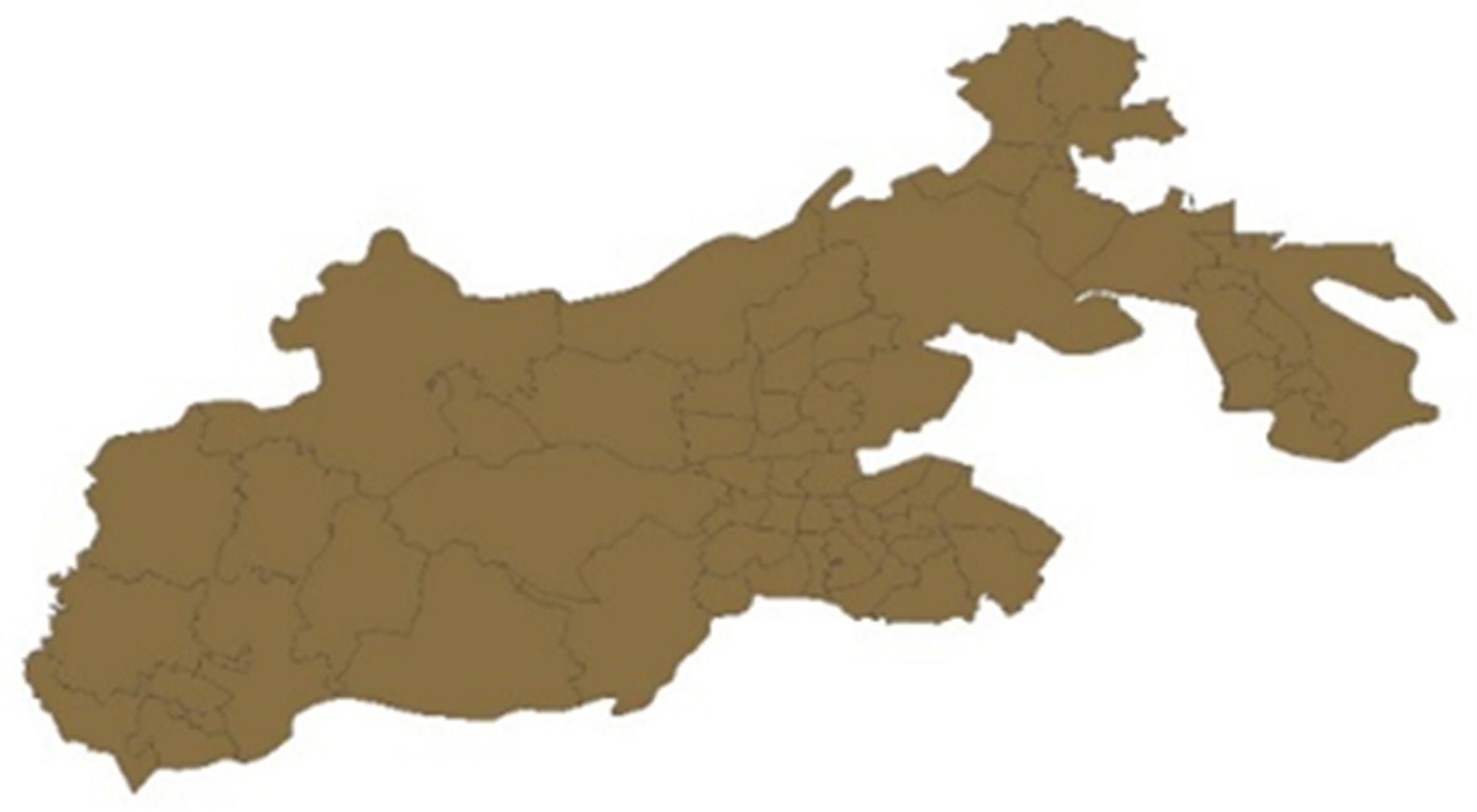
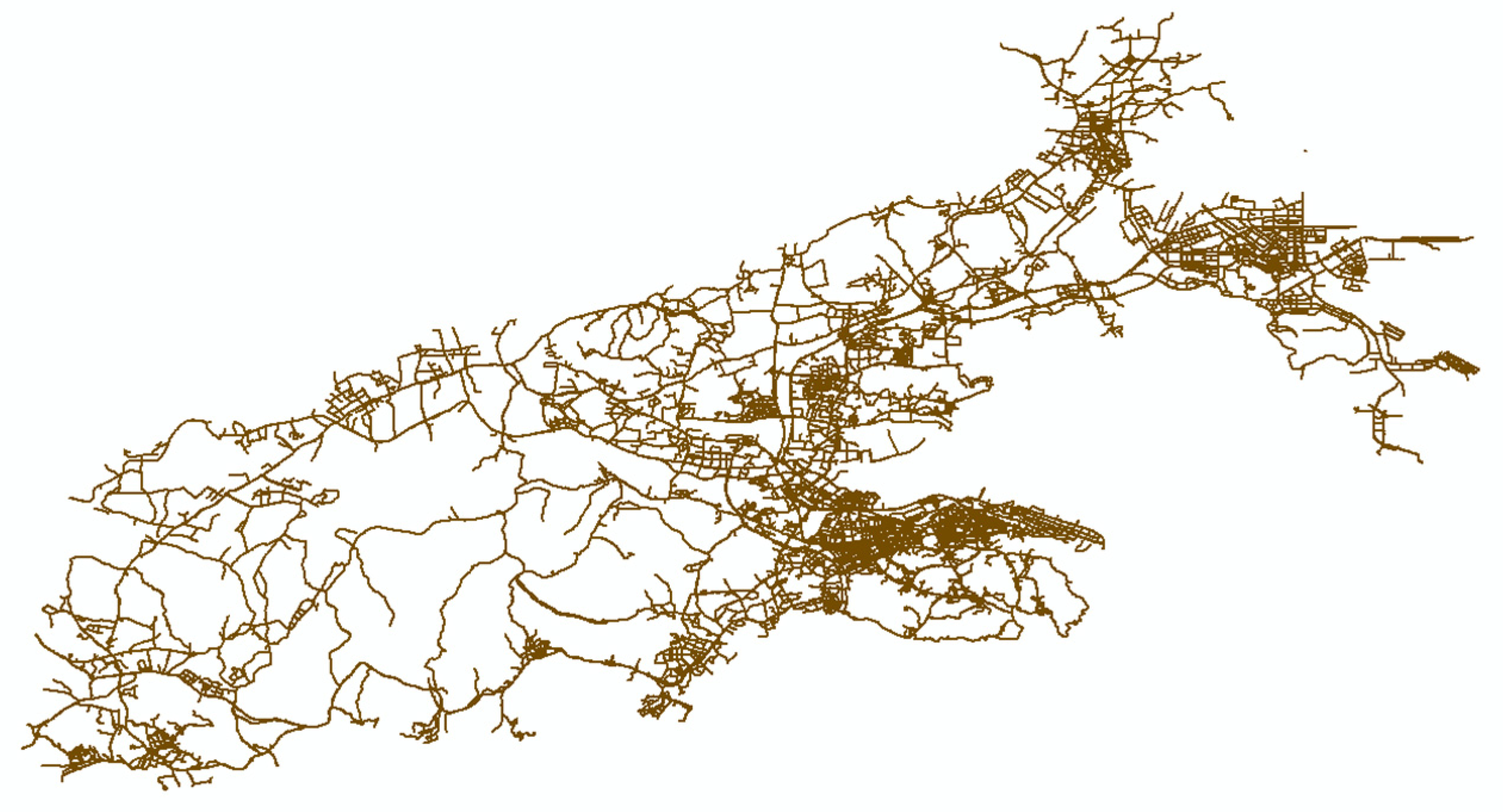



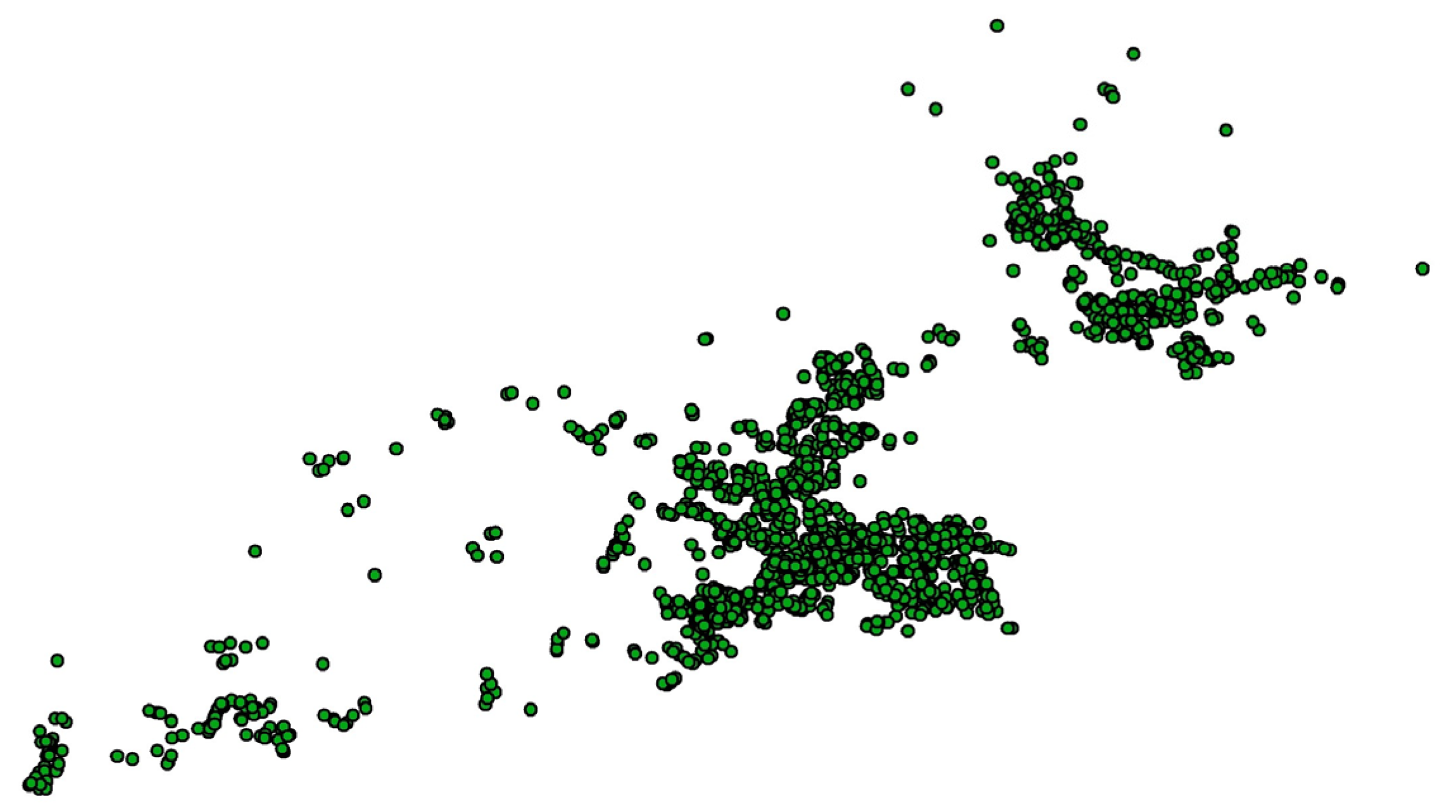
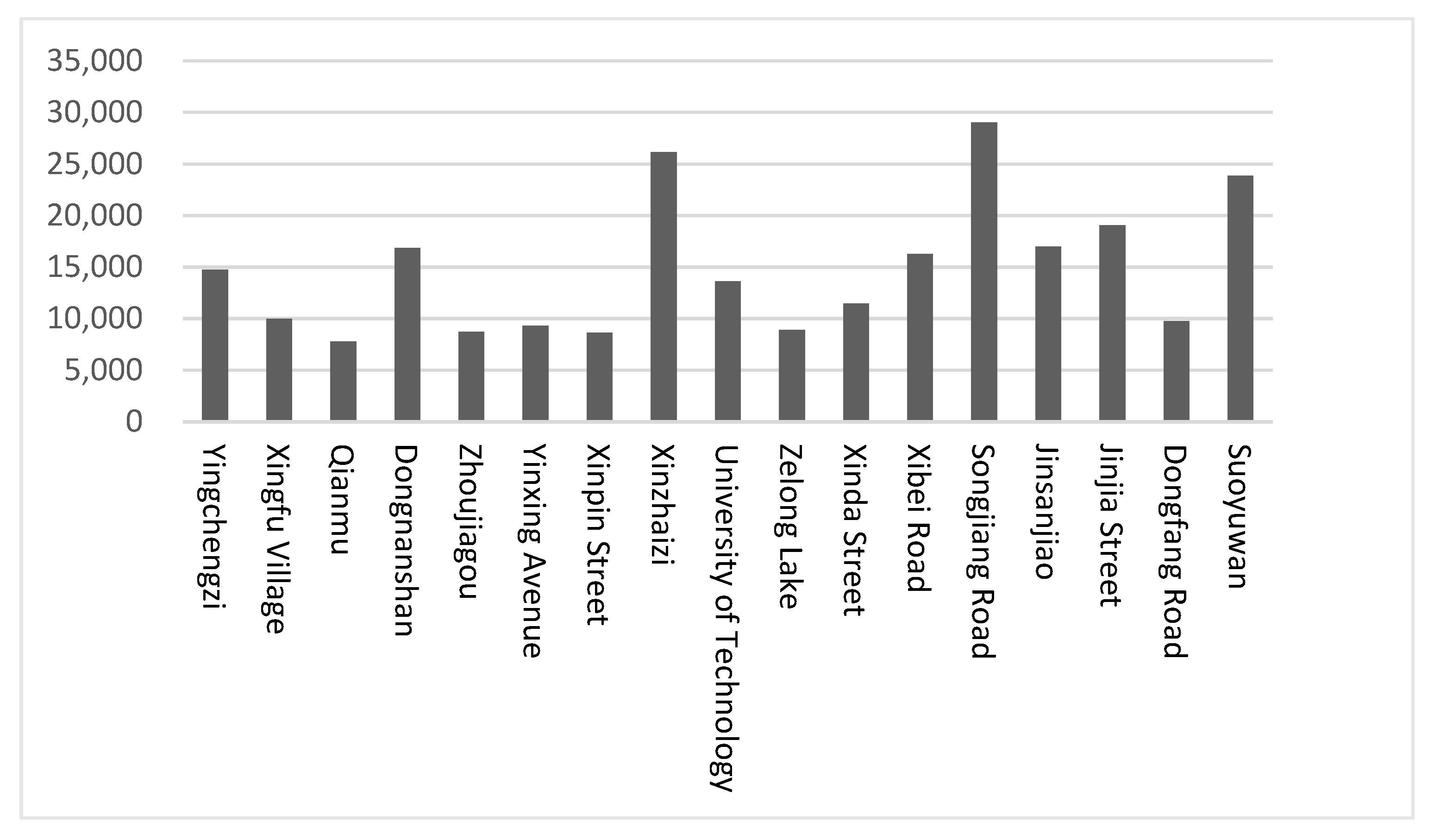
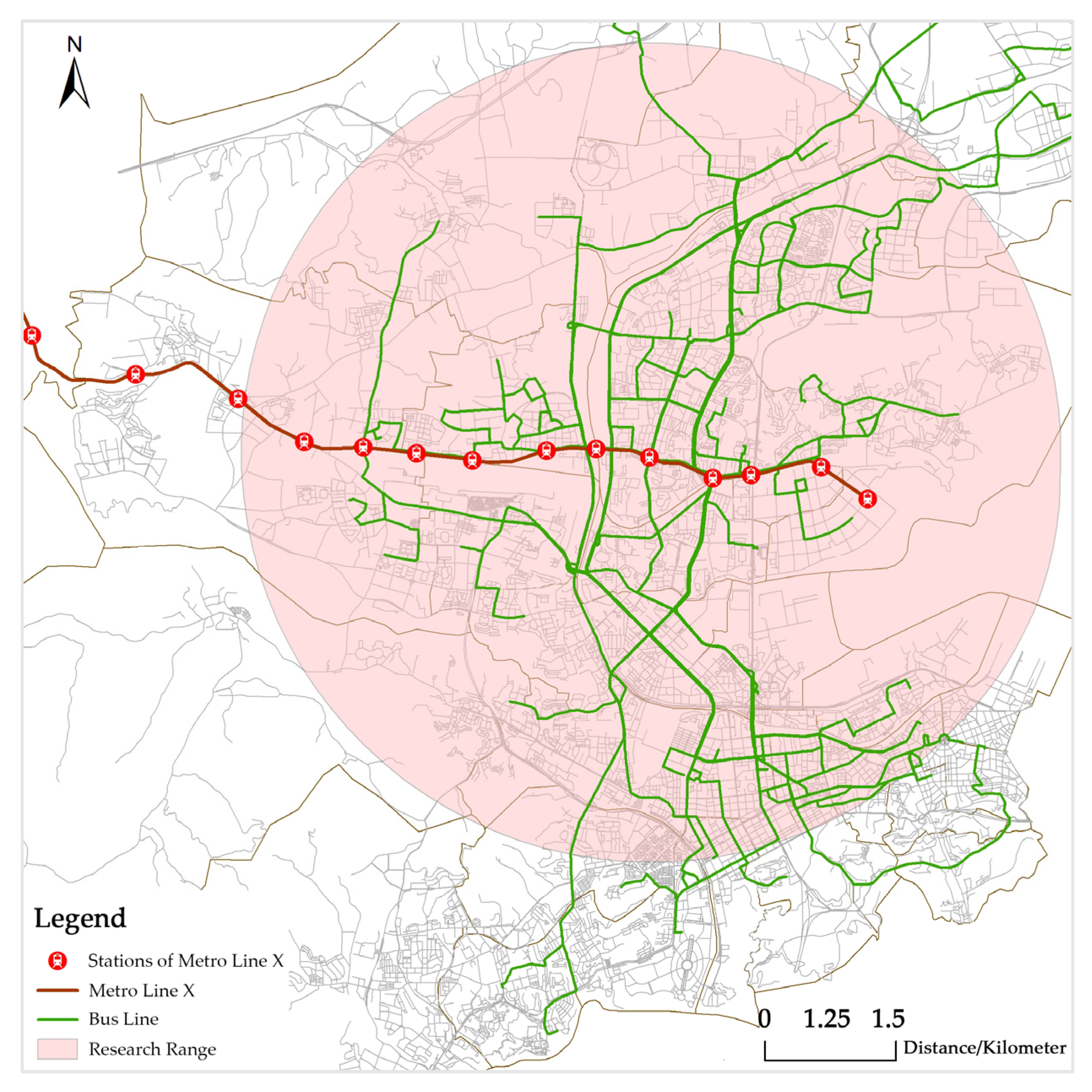
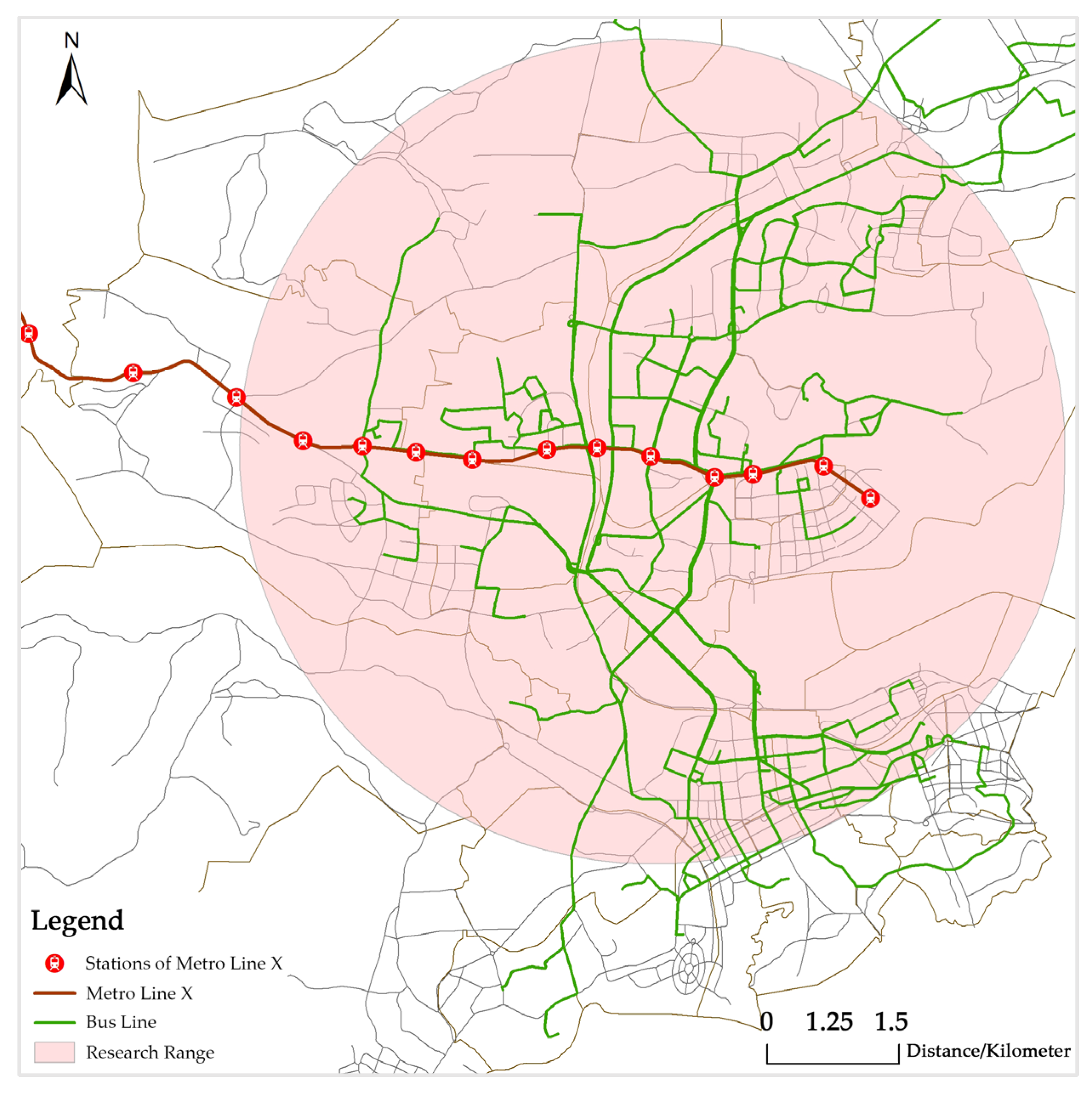

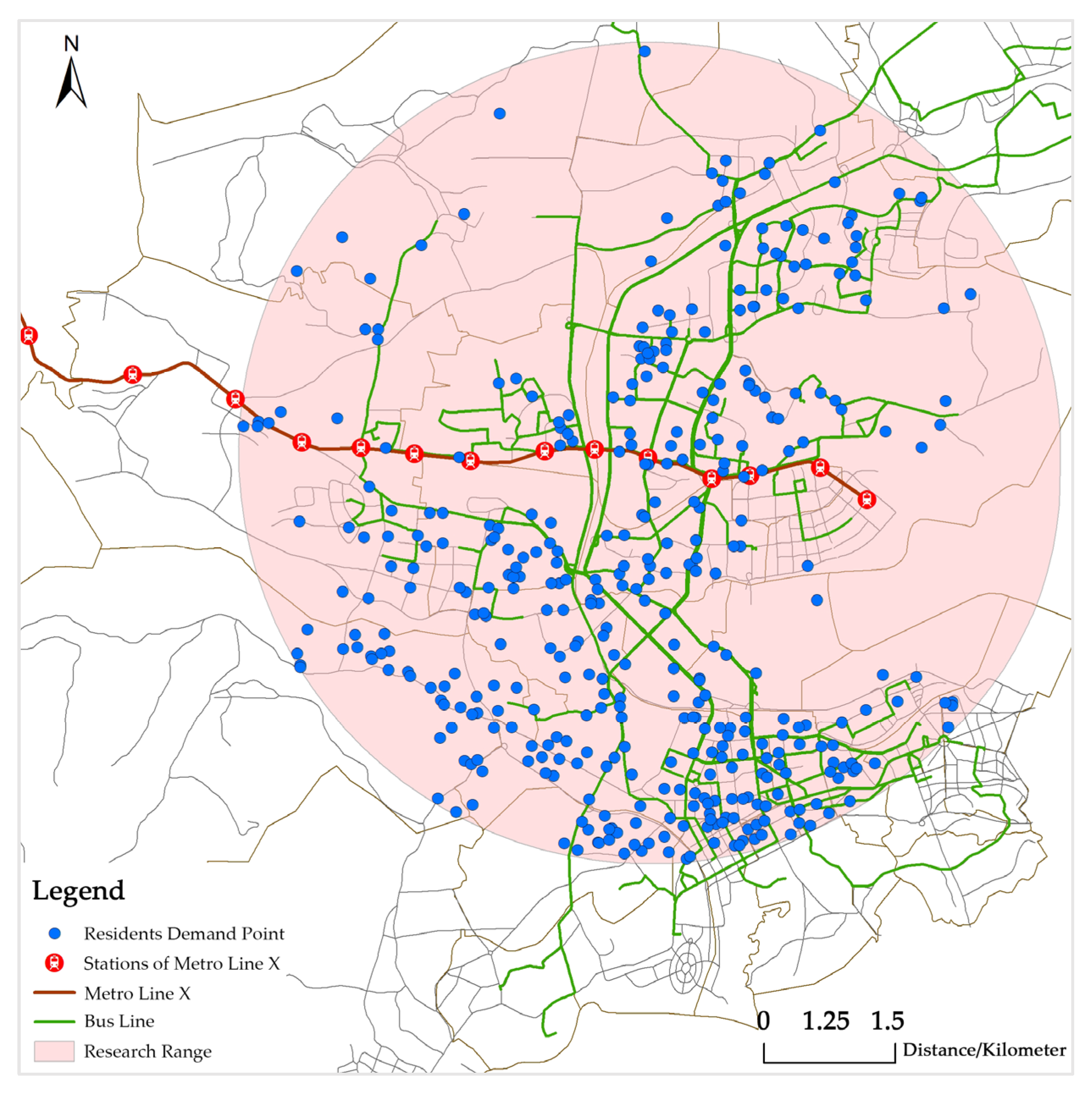
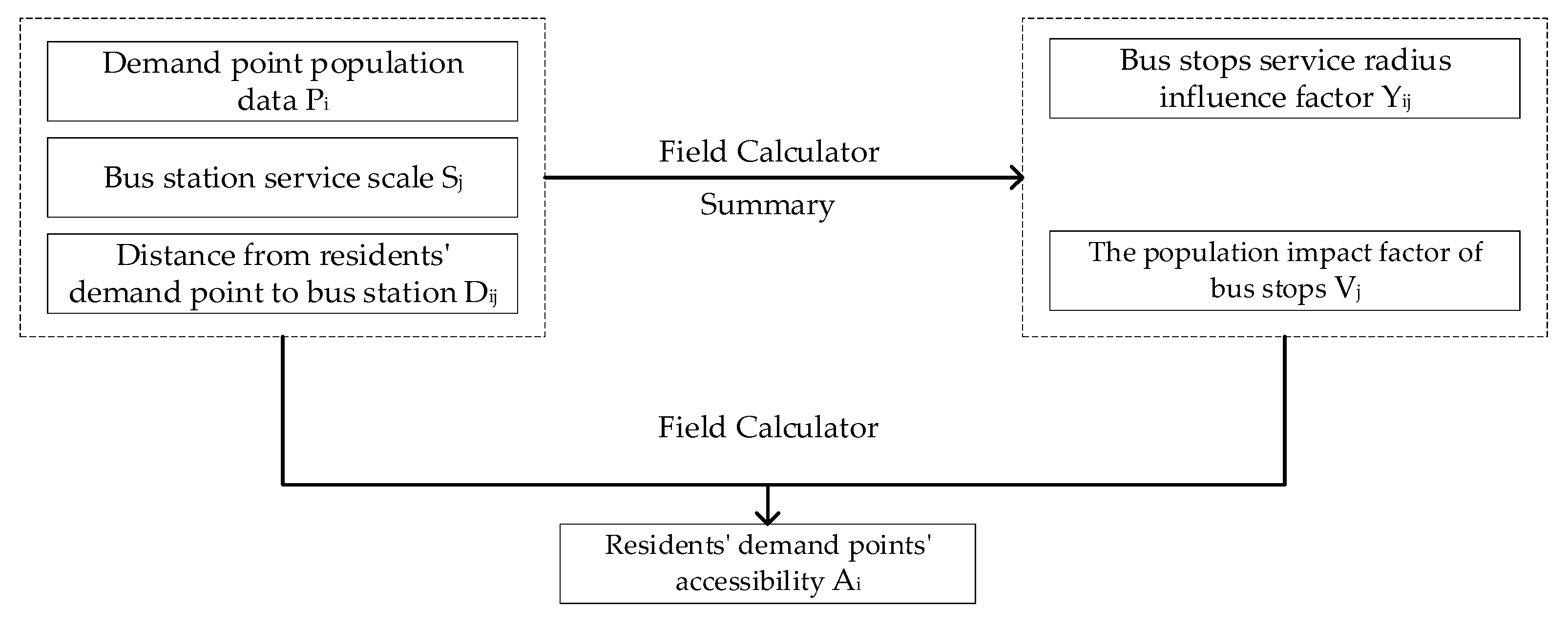
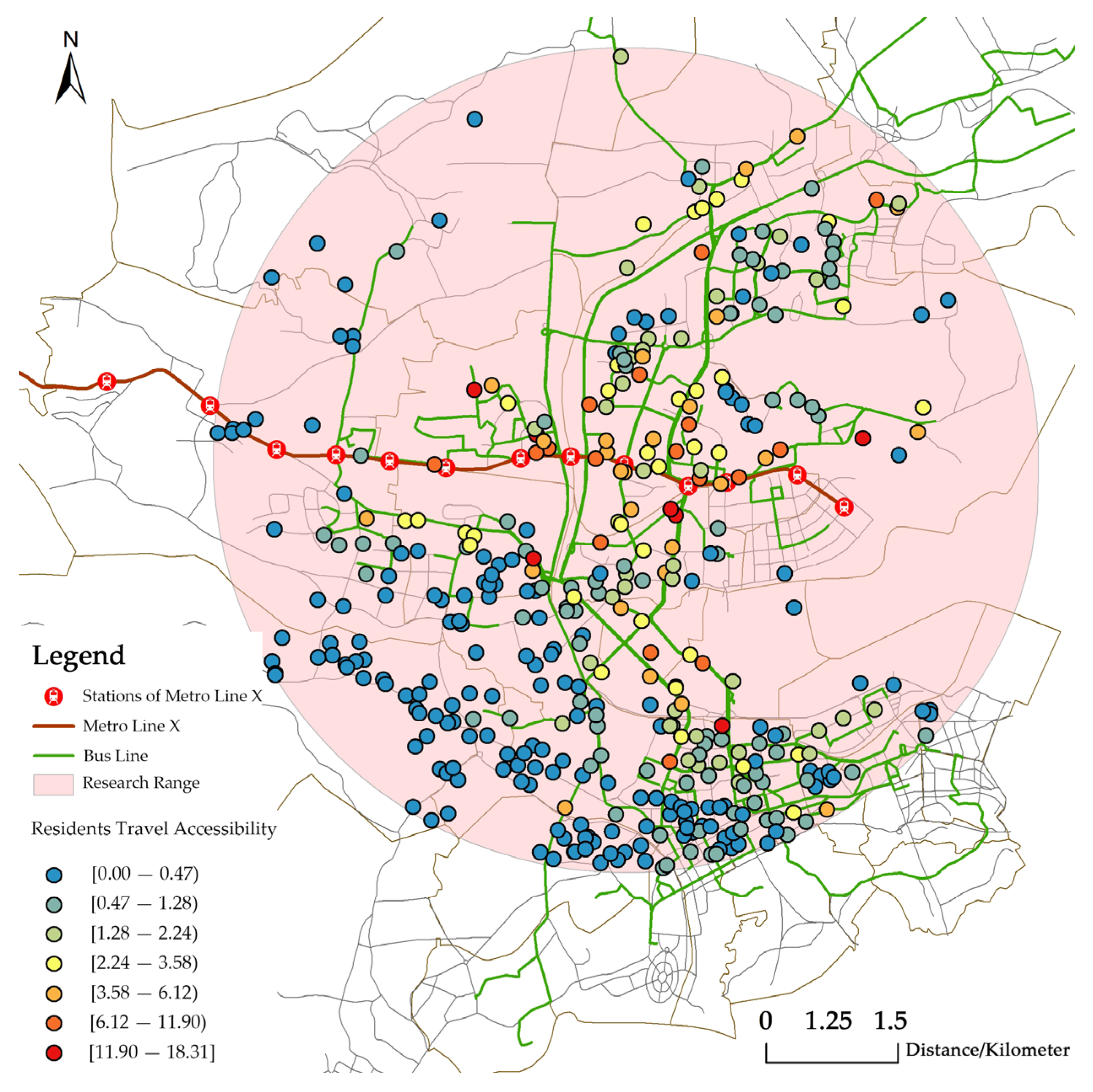

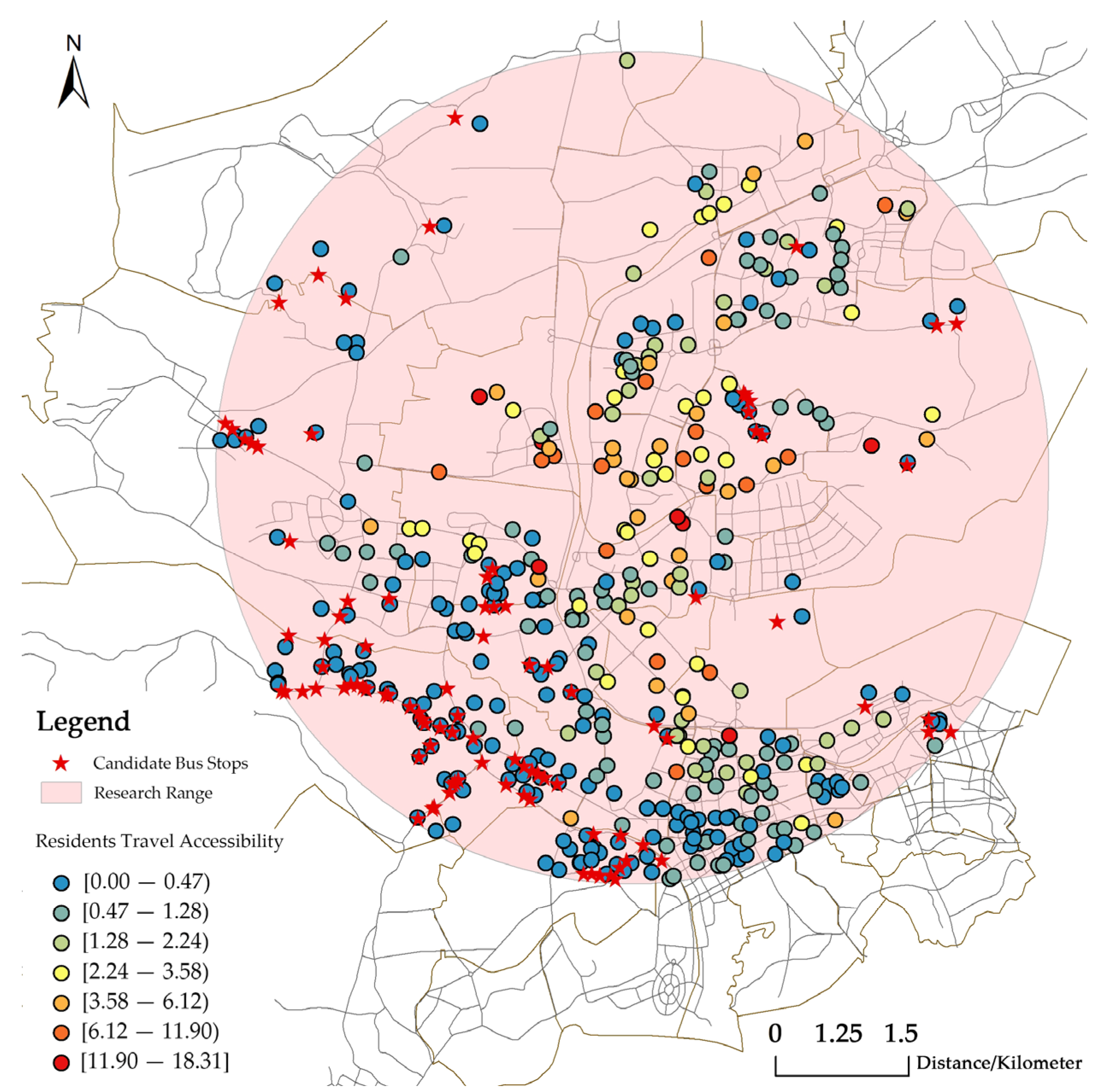
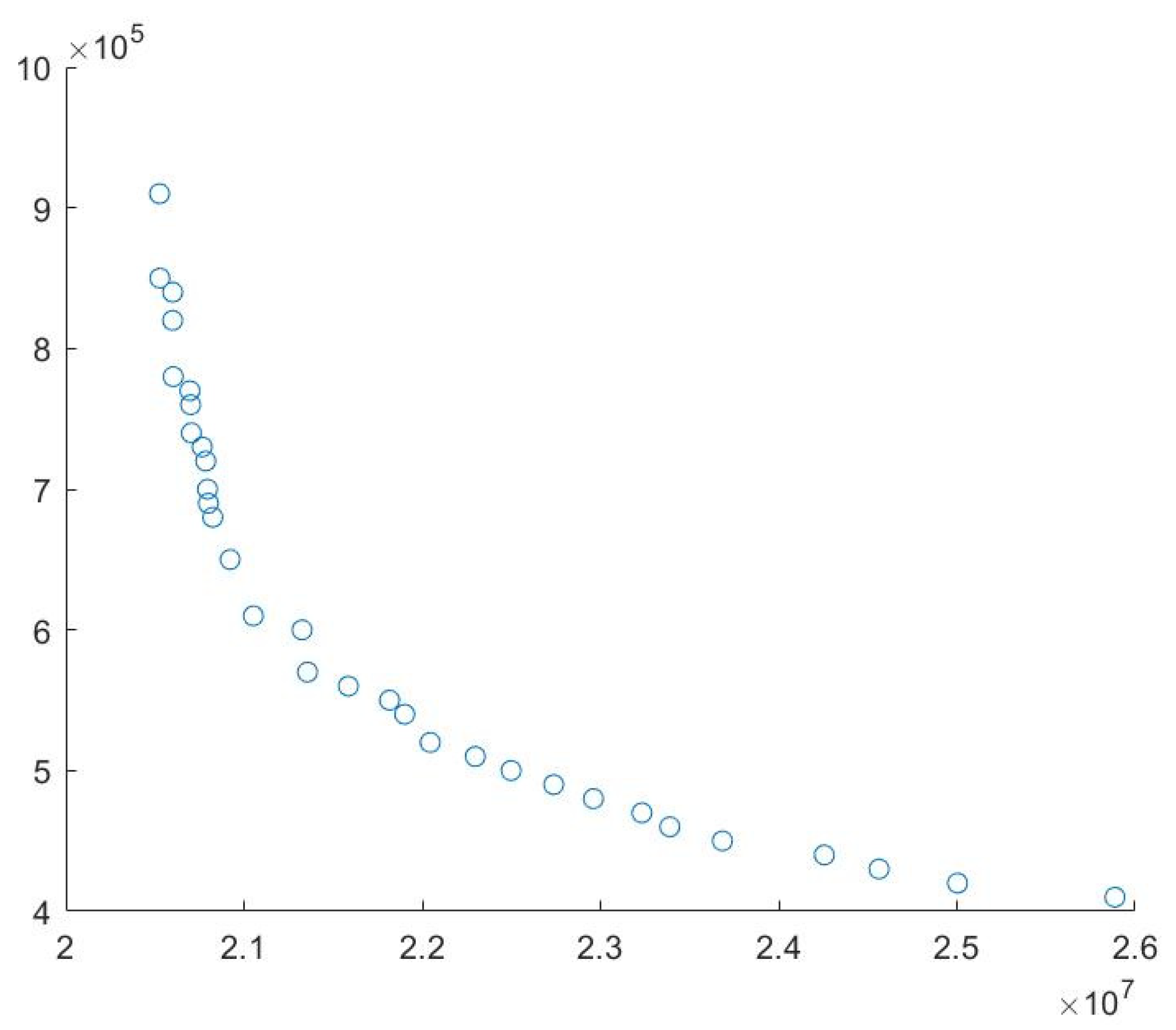
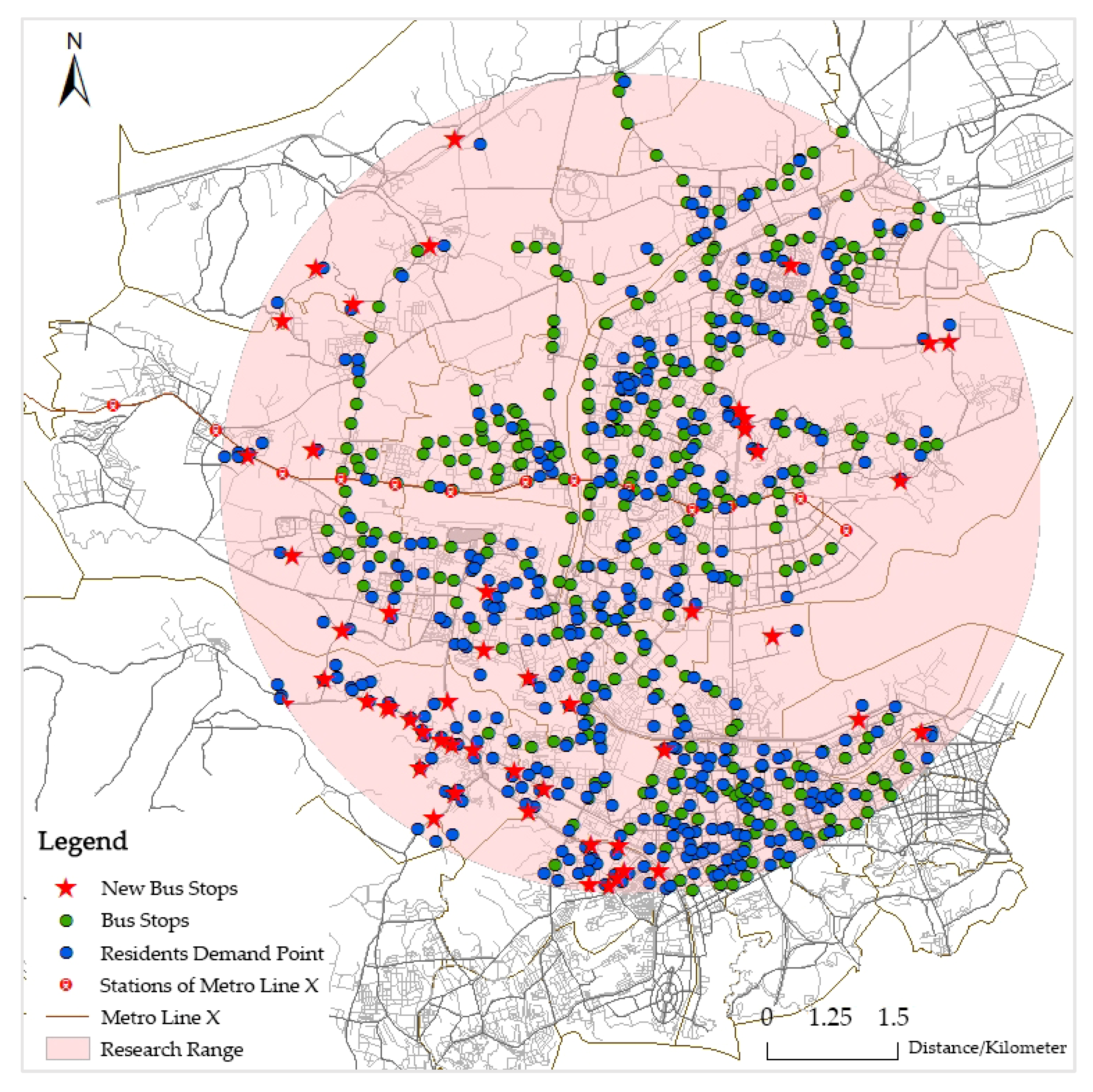

| Station Type | Radius of Attraction Area (km) | Scope of Attraction Area (km2) | Station Name |
|---|---|---|---|
| Transfer Station | 7.82 | 190.62 | Songjiang Road Station, Xinzhaizi Station, Jinjia Street Station, and Suoyuwan Station |
| Central Business Area Station | 6.00 | 111.62 | Xinda Street Station, Zelong Lake Station, and University of Technology Station |
| Suburban Station | 11.92 | 444.87 | Xinping Street Station, Yinxing Avenue Station, Zhoujiagou Station, Dongnanshan Station, Qianmu Station, Xingfu Village Station, and Yingchengzi Station |
| Regular Residential Area Station | 6.62 | 136.15 | Dongfang Road Station, Jinsanjiao Station, and Xibei Road Station |
Disclaimer/Publisher’s Note: The statements, opinions and data contained in all publications are solely those of the individual author(s) and contributor(s) and not of MDPI and/or the editor(s). MDPI and/or the editor(s) disclaim responsibility for any injury to people or property resulting from any ideas, methods, instructions or products referred to in the content. |
© 2023 by the authors. Licensee MDPI, Basel, Switzerland. This article is an open access article distributed under the terms and conditions of the Creative Commons Attribution (CC BY) license (https://creativecommons.org/licenses/by/4.0/).
Share and Cite
Wang, S.; Zuo, Z.; Liu, Y. Study on Location of Bus Stop in Subway Service Area Based on Residents’ Travel Accessibility. Sustainability 2023, 15, 4517. https://doi.org/10.3390/su15054517
Wang S, Zuo Z, Liu Y. Study on Location of Bus Stop in Subway Service Area Based on Residents’ Travel Accessibility. Sustainability. 2023; 15(5):4517. https://doi.org/10.3390/su15054517
Chicago/Turabian StyleWang, Sini, Zhongyi Zuo, and Yan Liu. 2023. "Study on Location of Bus Stop in Subway Service Area Based on Residents’ Travel Accessibility" Sustainability 15, no. 5: 4517. https://doi.org/10.3390/su15054517
APA StyleWang, S., Zuo, Z., & Liu, Y. (2023). Study on Location of Bus Stop in Subway Service Area Based on Residents’ Travel Accessibility. Sustainability, 15(5), 4517. https://doi.org/10.3390/su15054517









